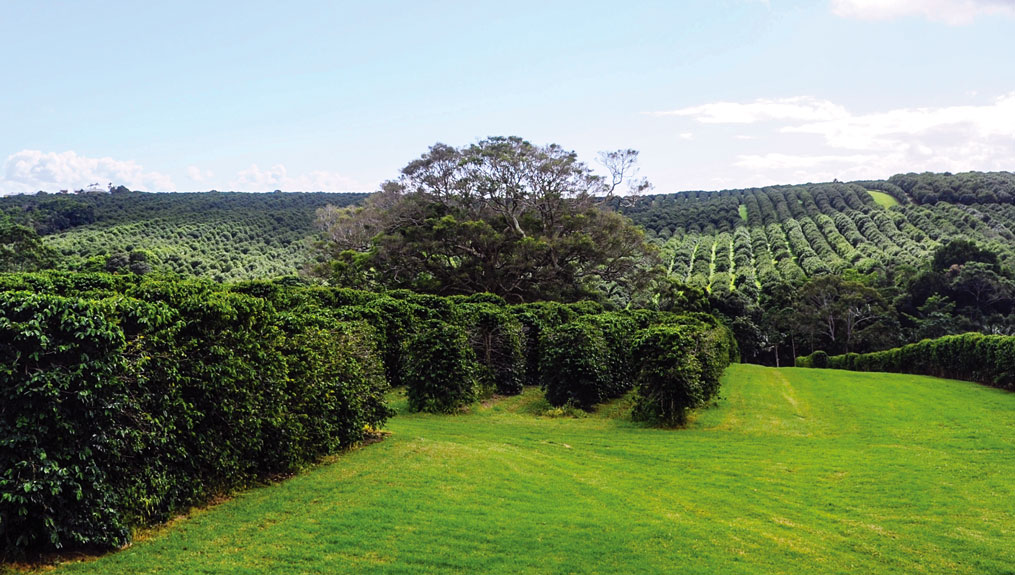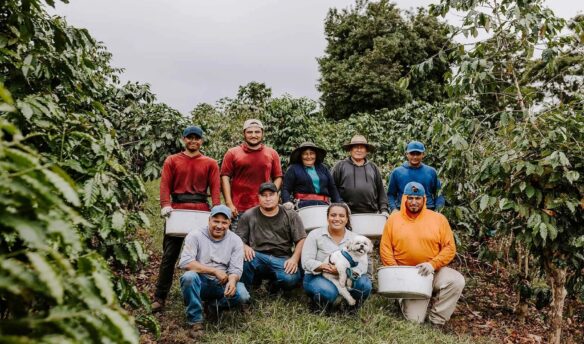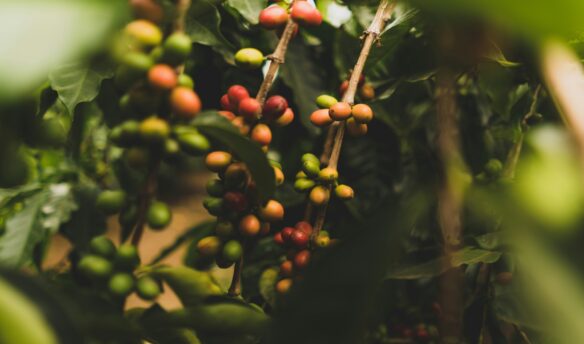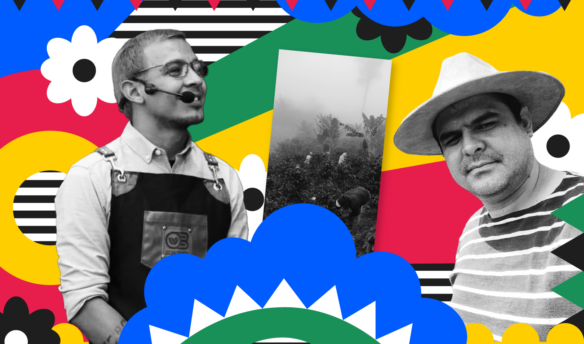Scenic Views of Zentveld’s coffee plantation include rolling hills of perfectly manicured coffee plants. Photo courtesy of Zentveld’s Coffee.
[M]ore so recognized for its wine, hearty Aussie brunches, and coffee consumption, Australia is not a nation one immediately thinks of when it comes to coffee production. But a few farmers are not shying away from utilizing the land in hope of one day matching the likes of Africa and Central America.
Infrastructure
When it comes to coffee consumption, Australians drink an average of 16.3 million cups of coffee per day, according to the Australian Bureau of Statistics. But only one percent of locals will even taste Australian coffee.
“Our local beans are rare,” says Rebecca Zentveld, owner of Zentveld’s Plantation and Coffee Roastery and president of the Australian Subtropical Coffee Association. “We don’t even rank on the production list of international coffee.”
Established in 1993, Zentveld’s, operated by Rebecca and John Zentveld, is based in Newrybar, minutes away from the sunny beaches of Byron Bay in New South Wales.
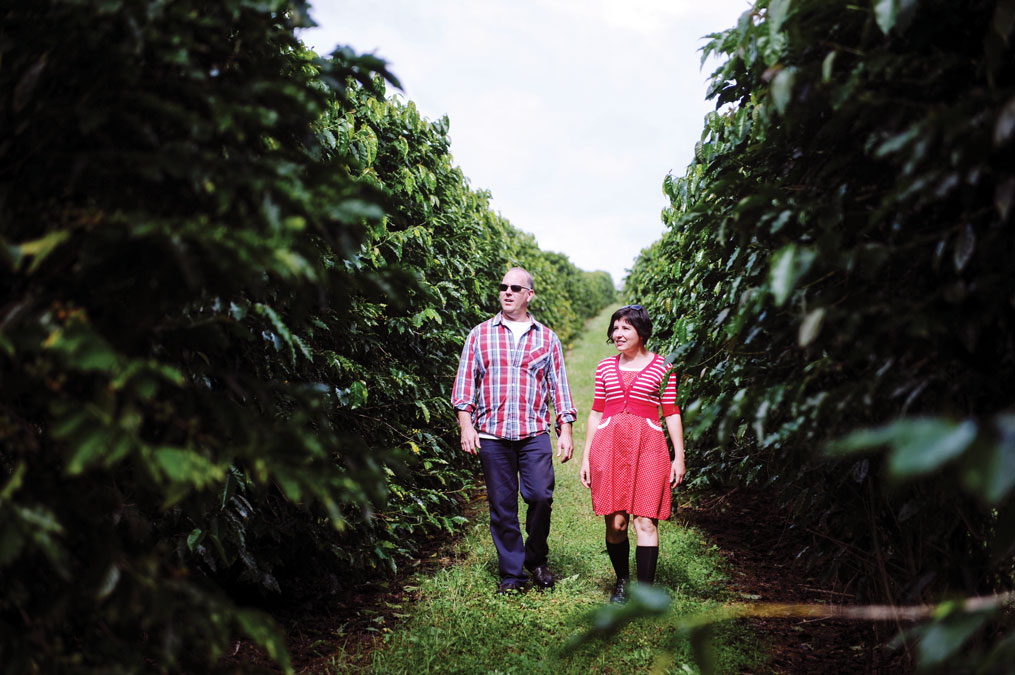
Despite having more than 35 Australian subtropical coffee growers between Noosa and Coffs Harbour, who produce up to 600 tons of dry green beans a year from 850,000 trees, Zentveld says one of the major challenges continuing to stump the Australian coffee industry is the loss of arable land to real estate.
Farmers have been tempted to sell out, owners from cities not interested in farming are pulling out trees, and across “the most viable food productive lands in Australia, we are replacing food farming with growing houses instead,” explains Zentveld.
“It is a concern of mine—the replacement of food-growing to house-growing on some of our best food land in Australia,” she adds.
Since there are only a few pockets of suitable terroir and microclimate land available across northern NSW and Queensland, this is proving to be a major setback for an industry that wants to expand, grow, and export.
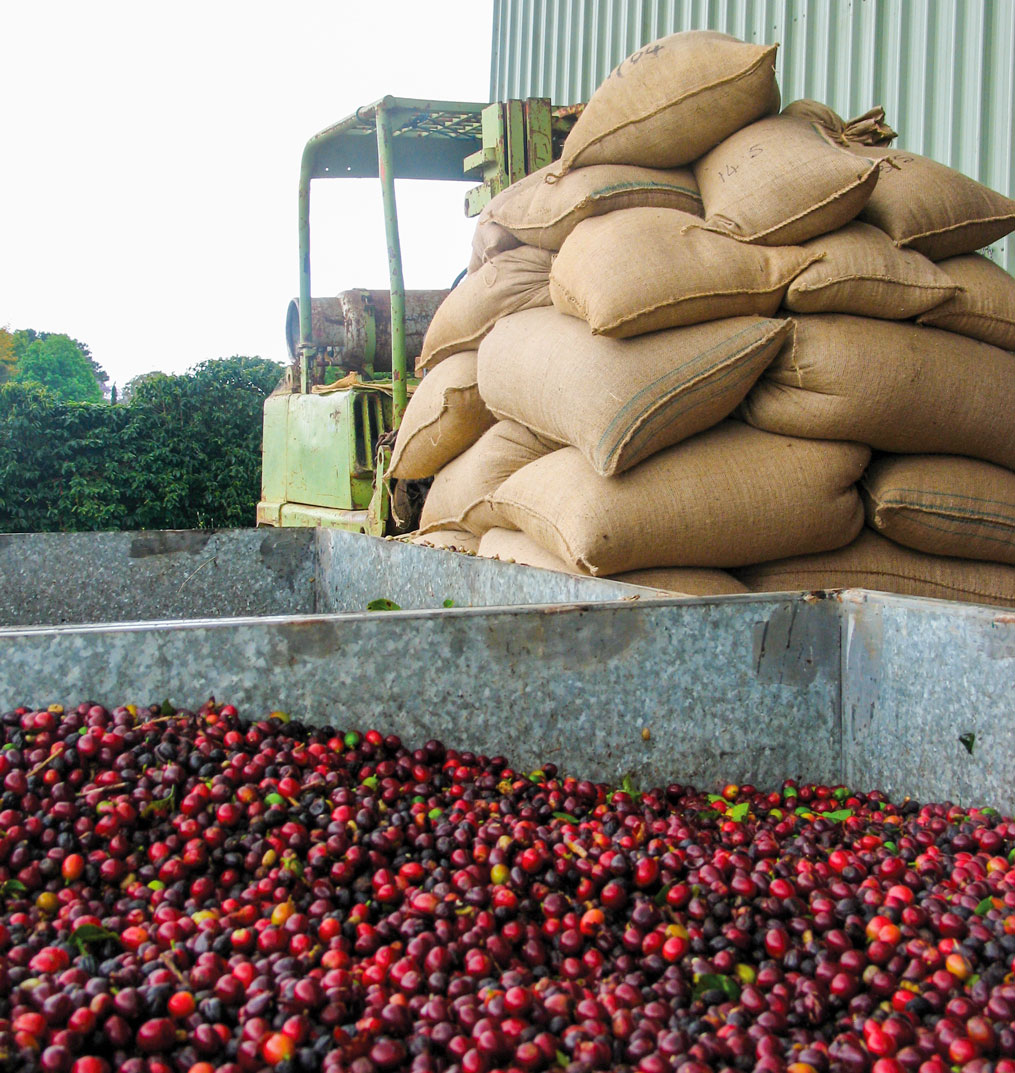
Labor Costs
Labor costs are another issue, as Australia is a wealthier nation compared to other coffee lands.
“Our labor and economic conditions set a much higher profitable benchmark for any grower or landowner considering growing coffee or any other food for that matter,” says Zentveld.
“How can we compete with foreign coffees when our labor costs are thirty dollars per hour compared to the cost of labor in other lands?” she continues. “What do you reckon hand-pickers or small growers in Papua New Guinea, Indonesia, Southeast Asia, across the African nations or Central America get paid per hour? Clearly, it is hard to compete as an Australian grower. So we roaster-buyers who choose Australian, do so knowing we will be paying a premium for beans that allow our growers to earn an Australian income.”
Zentveld adds that nearly all the country’s growers are individual family owned and operated.
“No multinationals, no investors, just real Australian farming families,” she says. “We can feel good in choosing to buy Australian coffee.”

Quality
In relation to the quality of Aussie-grown beans compared to beans grown in Africa and Central America, Zentveld refers to research done by Australian Subtropical Coffee Association’s agronomist David Peasley, whose findings support the following:
“In the early days, overcoming data-free observations was a big hurdle and comments such as, ‘Coffee must have shade to produce high-quality coffee’ and ‘Hand-picked coffee is better quality than machine-harvested coffee,’ along with, ‘High altitude is required to grow the best quality coffee,’ provided challenges for the early research efforts in the subtropics in the 1980s and 1990s.
“These taste tests soon showed that coffee quality was not simply a function of altitude or variety or location but a combination of all these including soil type and microclimate and that the coolness of the ripening period was a major ingredient of coffee quality. That could be achieved at high altitude or high latitude or under shade.”
Peasley went on to say that his research of coffee growing and harvesting in Brazil, Hawaii, Sri Lanka, and Colombia, along with observations in Australia, convinced him that “German author Bernhard Rothfos had it right in 1985 when he said, ‘Quality does not depend on the coffee’s origin or method of preparation. First-class coffee is a product of care, experience and accuracy at every single stage of production.’”
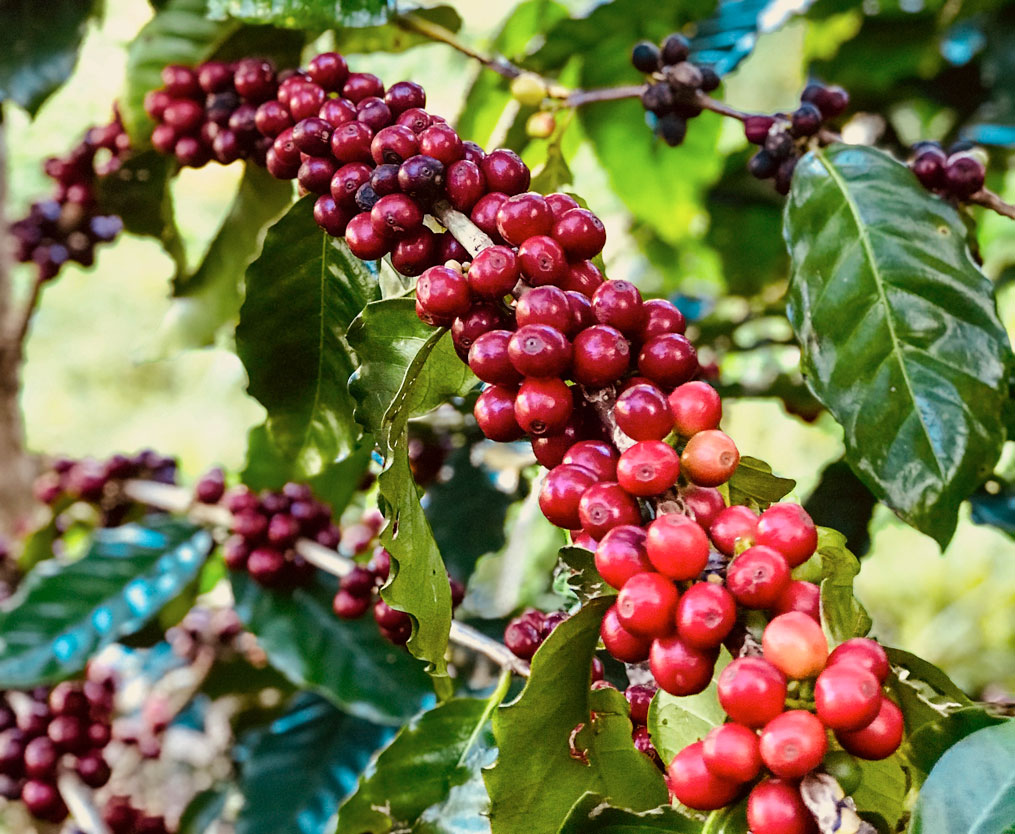
Climate
The process of growing coffee is very similar to that of wine, and with Australia’s naturally cooler climate allowing for a longer ripening season of 10 months or more, there is a strong chance of the nation developing its coffee growing possibilities.
“It’s just like wine—longer, slower fruit and bean development allows for more sweetness and nuances to develop within,” says Zentveld. “Compared to hotter coffee lands, we are growing fine-quality coffee at lower altitudes but with comparatively cooler climate quite close to sea level and the coast.”
The Australian crop is also unique as it’s one of the few coffee-growing regions that doesn’t use pesticides and herbicides. Zentveld takes pride that the land is currently unaffected by coffee pests or diseases, allowing their product to be grown “practically organic.”
Education
Candy MacLaughlin, general manager at Skybury Coffee in Queensland, says Australia produces a small quantity of coffee and continues to produce small yields compared to the rest of the world because it’s seen as a rare commodity.
“At the beginning [the biggest challenge] was breaking into new markets, particularly on the international market for the green coffee,” she says.
MacLaughlin’s parents bought Skybury about 30 years ago, without much previous knowledge about coffee or farming. This venture turned into a lifelong passion, with the plantation now multifaceted with red papaya crop, a roastery, a dedicated research lab, and a tissue culture facility, as well as a visitor/tourist information center and a café.
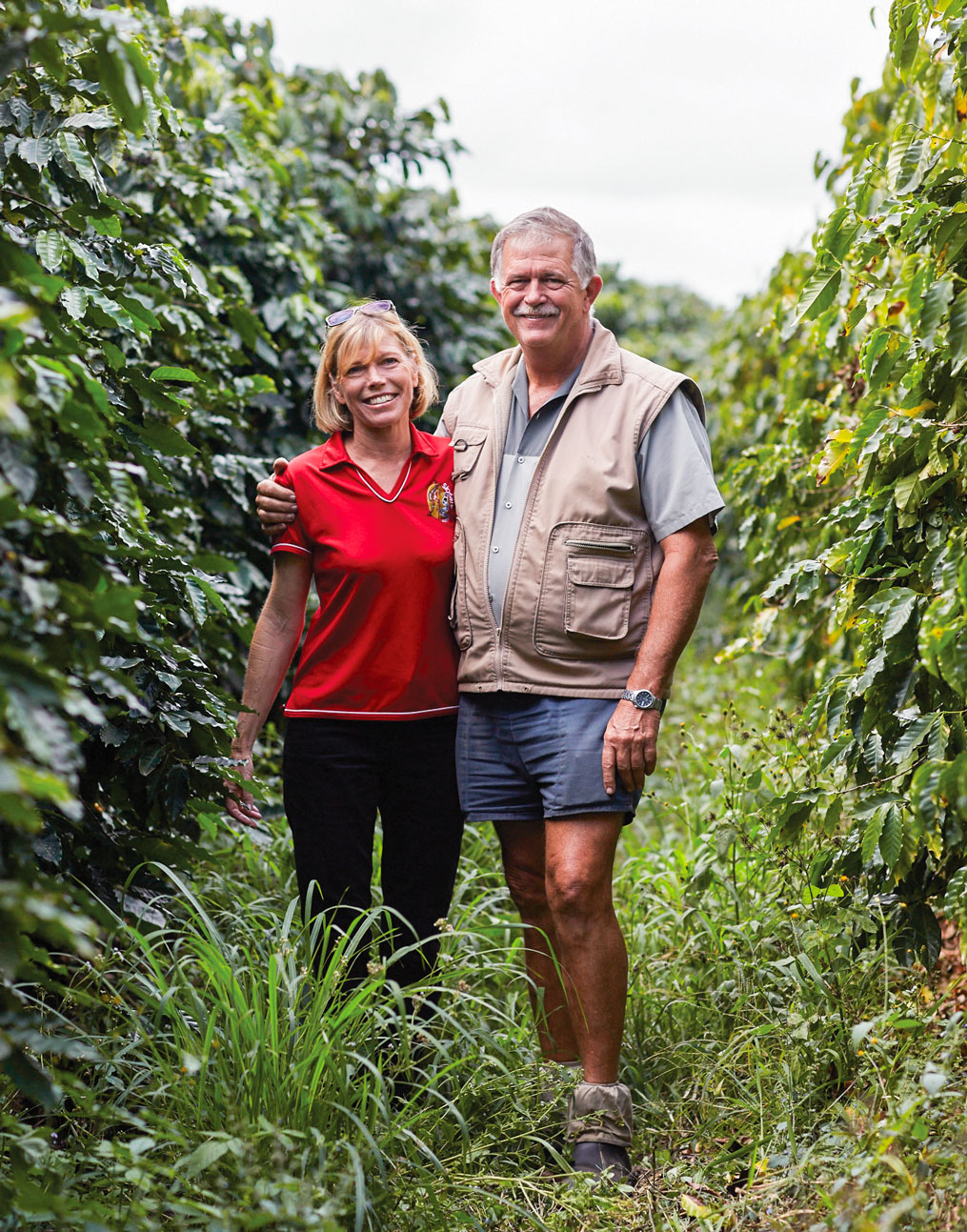
Before venturing into coffee roasting 12 years ago, the MacLaughlins were green coffee producers only. Now Skybury coffee is “well recognized and sought after [in the international market] with many brokers purchasing in advance of the coming harvest,” she says.
However, it’s the domestic market that is the main challenge, as it’s much slower due to competition, cost, infrastructure, and education.
“It’s still a niche product,” says MacLaughlin. “New South Wales has the capacity to produce coffee, but we haven’t had more than two to three new coffee farms in the past ten years and not all of them have come to production.
“It’s a hard crop to harvest and process and the infrastructure [in Australia] is insubstantial, following the actual growing of the crop,” she continues. “I do think it’s still a positive industry and those that do farm are passionate. It would be great to see more farmers venture into coffee. We can all have our distinctive taste profile, just like the wine regions.”
Australian coffee remains to be part of the “boutique industry” because it’s a non-essential item, MacLaughlin explains, with people able to go without it if they have to or take a cheaper option.
“There are some amazing international coffees, so we also have to be realistic and keep on our game to ensure that we are offering the best possible coffee,” she says.
The other challenge is the consumer, with many more concerned about whether the coffee is freshly roasted rather than where it comes from. Although the interest is definitely there, it all comes down to whether consumers want to spend money on Australian coffee over and beyond what they might have to for international coffee.
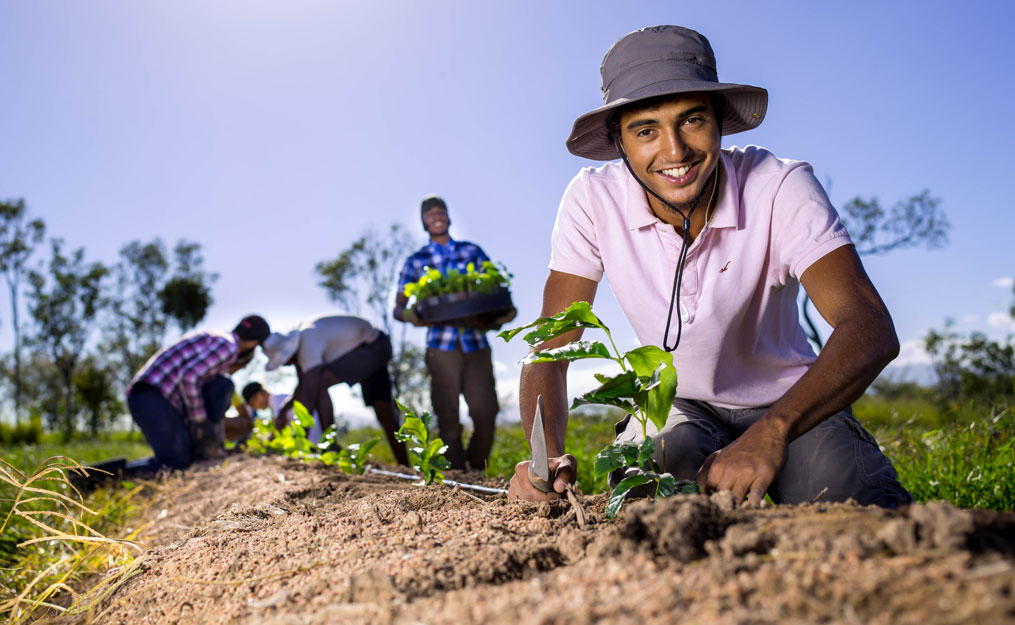
“They have to think long and hard about it,” says MacLaughlin. “We all have loyal coffee followers, and this makes what we do fun and worthwhile. I still think that there is so much to gain in terms of traction for the Australian coffee industry and I think that consumers will support us through this process. We are growing each year with our domestic market, but it’s just not a fast process.”
For the next few years, Skybury’s goals are to continue growing internationally and domestically, to build a reputation as being a great coffee producer, and to keep improving farming techniques, which will in turn improve quality and taste.
“We are also producing shade-grown coffee—coffee that is grown under a papaya tree,” says MacLaughlin. “It has a great note with respect to acidity and we can only produce so much of this coffee each year and that keeps the demand high too.”
The Future
Sarah Baker, editor of BeanScene and Coffee Group, says that more professionals are now choosing to discover their own backyard, rather than the traditional trips to origin, which involve “international travel with thousands of kilometers, trekking into remote regions in non-English speaking countries.”
“For this reason, there’s more interest in baristas and companies arranging travel tours to Australia’s coffee-growing regions for training and education on coffee production,” she says. “The educational experience is an eye-opening experience for baristas to understand the complete ‘crop to cup’ photography.”
One sign that Australia is positioning itself as a coffee-producing nation is its involvement in a World Coffee Research (WCR) multi-varietal trial to test new hybrid varietals, also known as the F1 hybrids.
“By 2050, a majority of current coffee-growing countries will no longer be viable to produce the volume or potentially the quality of coffee they did due to the effects of climate change,” says Baker.
Greg Meenahan of WCR confirms that the global industry will experience a shortfall of 182 million bags of coffee by 2050.
“Demand for coffee is rising about 1.5 percent to 2 percent a year, [and] it is expected to double by 2050,” says Meenahan. “Research has shown us that if nothing is done, more than half of the world’s coffee land will become unsuitable because of climate change.”
In response, WCR is conducting an international multi-location coffee variety trial, where 35 coffee types across 23 countries are tested to measure the performance in different climates, including Australia.

Scientists at Sydney’s Southern Cross University are testing 20 climate-resistant varieties, which, once accessible to the market, will have a tremendous impact.
“In the production sector, today, information and availability of good varieties is scarce,” explains WCR’s scientific director, Christophe Montagnon. “When that changes, farmers will be able to make an informed choice about the variety that fits its own agronomic needs and market [quality]….Development projects that are supporting renovation of coffee farms around the world will be much more efficient because instead of replanting ‘random’ coffee trees, they will go for real improved variety.”
Sydney-based Single O has become the first roaster in Australia to import a full container of these climate-resilient coffees, featuring the F1 hybrid, Starmaya. This is a high-yielding, rust-resistant variety that can be grown at multiple altitudes. Other climate-resistant varietals also available are Marsellesa and Centroamericano. These F1 hybrids are created through a coffee-breeding process where researchers utilize the coffee plant’s DNA to help select which varieties to keep and which ones to let go. Once the varieties become readily available for the market, this will mean production security, less vulnerability, and improved quality.
Evidently, the supply and demand of coffee will continue growing, and with Australia’s cooler climate, passion for the product, and sustainable growing ethic, who knows? Australia just might step it up and contribute to the world’s constant demand for coffee.

